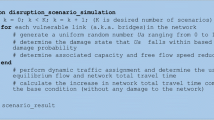Abstract
The presented spatial risk assessment method allows for managing critical network infrastructure in urban areas under abnormal and future conditions caused e.g., by terrorist attacks, infrastructure deterioration or climate change. For the spatial risk assessment, vulnerability maps for critical network infrastructure are merged with hazard maps for an interfering process. Vulnerability maps are generated using a spatial sensitivity analysis of network transport models to evaluate performance decrease under investigated thread scenarios. Thereby parameters are varied according to the specific impact of a particular threat scenario. Hazard maps are generated with a geographical information system using raster data of the same threat scenario derived from structured interviews and cluster analysis of events in the past. The application of the spatial risk assessment is exemplified by means of a case study for a water supply system, but the principal concept is applicable likewise to other critical network infrastructure. The aim of the approach is to help decision makers in choosing zones for preventive measures.
Similar content being viewed by others
References
Brashear J, Stenzler J (2007). Water and wastewater specific RAMCAP guidance. In: AWWA/WEF Joint Management Conference, Portland, OR, USA, Feb. 25–28
Chen Y, Xu Y P, Yin Y X (2009). Impacts of land use change scenarios on storm-runoff generation in Xitiaoxi Basin, China. Quat Int, 208(1–2): 121–128
Ezell B C (2007). Infrastructure vulnerability assessment model (IVAM). Risk Anal, 27(3): 571–583
Gleick P H (2006). Water and terrorism. Water Policy, 8(6): 481–503
Gruber U, Bartelt P (2007). Snow avalanche hazard modelling of large areas using shallow water numerical methods and GIS. Environ Model Softw, 22(10): 1472–1481
Jayaram N, Srinivasan K (2008). Performance-based optimal design and rehabilitation of water distribution networks using life cycle costing. Water Resour Res, 44(1): 1–15
Jiang Y, Liu J, Cui Q, An X, Wu C (2011). Land use/land cover change and driving force analysis in Xishuangbanna Region in 1986–2008. Frontiers of Earth Science, 5(3): 288–293
Khanal N, Buchberger S G, McKenna S A (2006). Distribution system contamination events: Exposure, influence, and sensitivity. J Water Resour Plan Manage, 132(4): 283–292
Liu J W, Wang Z M, Xie F R (2010). Seismic hazard and risk assessments for Beijing-Tianjin-Tangshan Area, China. Chinese Journal of Geophysics, 53(2): 318–325 (in Chinese)
Mansouri Daneshvar M, Bagherzadeh A (2011). Landslide hazard zonation assessment using GIS analysis at Golmakan Watershed, northeast of Iran. Frontiers of Earth Science, 5(1): 70–81
Mark O, Wennberg C, van Kalken T, Rabbi F, Albinsson B (1998). Risk analyses for sewer systems based on numerical modelling and GIS. Saf Sci, 30(1–2): 99–106
Merz R, Bloschl G, Humer G (2008). National flood discharge mapping in Austria. Nat Hazards, 46(1): 53–72
Möderl M, Fetz T, Rauch W (2007). Stochastic approach for performance evaluation regarding water distribution systems. Water Sci Technol, 56(9): 29–36
Möderl M, Kleidorfer M, Sitzenfrei R, Rauch W (2009). Identifying weak points of urban drainage systems by means of VulNetUD. Water Sci Technol, 60(10): 2507–2513
Möderl M, Rauch W (2011). Chapter 7-Spatial Distributed Risk Assessment for Urban Water Infrastructure. Clark R M, Hakim S, Ostfell A, eds. Handbook of water and Wastewater Systems Protection. Berlin: Springer, ISBN 9781461401889
Nilsson K A, Buchberger S G, Clark R M (2005). Simulating exposures to deliberate intrusions into water distribution systems. J Water Resour Plan Manage, 131(3): 228–236
Qu G S, Huang J F, Ma Z J, Li Y G, Ning B K (2007). The New Developments of Emergency Management of China and the Cases of Operation of CISAR in Recent Years. Paris: Atlantis Press. ISBN 9789078677031
Rossman L A (2000). EPANET 2 User Manual. National Risk Management Research Laboratory, USEPA, Cincinnati, USA
Rossman L A (2004). StormWater Management Model—User’s Manual Version 5.0. National Risk Management Research Laboratory, USEPA, Cincinnati, USA
UN DHA (1992). Internationally Agreed Glossary of Basic Terms Related to Disaster Management. UN DHA (United Nations Department of Humanitarian Affairs), Geneva
Vanham D, Fleischhacker E, Rauch W (2008). Technical note: Seasonality in alpine water resources management—a regional assessment. Hydrol Earth Syst Sci, 12(1): 91–100
Vreeburg J H G, van den, Hoven T J J, Hoogsteen K J (1994). A quantitative method to determine reliability of water supply systems. Water Supply, 12(1–2): ss7.9–7.13
Zhang Q, Zhang W, Chen Y D, Jiang T (2011a). Flood, drought and typhoon disasters during the last half-century in the Guangdong Province, China. Nat Hazards, 57(2): 267–278
Zhang W, Li H Z, Chen J P, Zhang C, Xu L M, Sang W F (2011b). Comprehensive hazard assessment and protection of debris flows along Jinsha River close to the Wudongde Dam site in China. Natural Hazards, 58(1): 459–477
Author information
Authors and Affiliations
Corresponding author
Rights and permissions
About this article
Cite this article
Möderl, M., Rauch, W. Spatial risk assessment for critical network infrastructure using sensitivity analysis. Front. Earth Sci. 5, 414–420 (2011). https://doi.org/10.1007/s11707-011-0202-1
Received:
Accepted:
Published:
Issue Date:
DOI: https://doi.org/10.1007/s11707-011-0202-1




